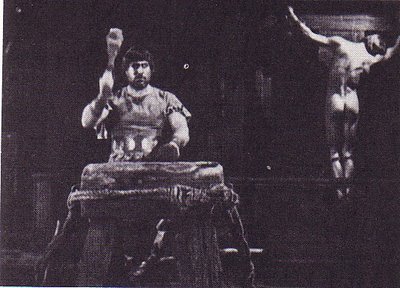Gay in the Cinema - 'The Celluloid Closet' Vito Russo
'The Celluloid Closet' (1981) by Vito Russo is an historical overview of how gays and lesbians have been represented in film. In the following years, it was paralleled by a tour presentation by Russo, with clips of films he discussed.
Now what interests me was the movement from direct to covert presentation, the turning point being the period of late twenties and then, in particular, 1930.
The earliest films portrayed gay quite openly. An experimental sound film, 'The Gay Brothers' (1895) produced by the Thomas Edison Studio, showed two men dancing. The title might be seen as some kind of cover, but the characters were gay acting and we (the wider audience) would be expected to understand this content.
 'The Soilers' (1923), a satire of the western 'The Spoilers' (1914), was a comedy starring Stan Laurel and set in the Alaska gold rush. In a fight scene between Laurel and the sheriff, a gay cowboy enters the saloon. All the mannerisms are on full display - eye batting, sashaying, hair fluffing, hand on hip work ... . Laurel, the winner of the fight but somehow now out in the street and in the gutter, gets blown a kiss by our friend, along with the mouthed words 'my hero':
'The Soilers' (1923), a satire of the western 'The Spoilers' (1914), was a comedy starring Stan Laurel and set in the Alaska gold rush. In a fight scene between Laurel and the sheriff, a gay cowboy enters the saloon. All the mannerisms are on full display - eye batting, sashaying, hair fluffing, hand on hip work ... . Laurel, the winner of the fight but somehow now out in the street and in the gutter, gets blown a kiss by our friend, along with the mouthed words 'my hero': Laurel rejects these attentions, and, in a turn that might surprise you, gets a potted plant on the noggin and is swept away with the trash. So our ire at such initial stereotyping subsides. Though this is comedy and we know that humour can mean reading a scene as the reverse of how life really is or should be.
Laurel rejects these attentions, and, in a turn that might surprise you, gets a potted plant on the noggin and is swept away with the trash. So our ire at such initial stereotyping subsides. Though this is comedy and we know that humour can mean reading a scene as the reverse of how life really is or should be.Films became more sexually explicit as the twenties roared. And alarms bells began to toll - by 1922, censorship bills were before the legislatures in 32 US states.
'Salome' (1923) initially had an openly gay relationship between two Syrian soldiers - but this was cut, with the censors describing the film as 'a story of depravity and immorality'.
Ben Hur (1926) did manage the following ('meaningfully' lit) scene for our delectation, but time was fast running out:
 Now, much under cover, the leads in Wings' (1927) had their women, but were the real lovers:
Now, much under cover, the leads in Wings' (1927) had their women, but were the real lovers: Things came to a head. Will Hayes, as head of the Motion Picture Producers and Distributors of America, achieved the Motion Picture Production Code in 1930, the Code that regulated (censored) films till the late 1960's.
Things came to a head. Will Hayes, as head of the Motion Picture Producers and Distributors of America, achieved the Motion Picture Production Code in 1930, the Code that regulated (censored) films till the late 1960's.A director, if he now wanted to have faggotry in his film, had get it in under deepest cover.
In Ben Hur (1959), William Wyler (director) and Gore Videl (writer) realized the rivalry between Messala (Stephen Boyd) and Ben-Hur (Charlton Heston) was not sufficiently motivated, with Vidal explaining his solution:
'I proposed the notion that the two had been adolescent lovers and now Messala had returned to Rome wanting to revive the love affair but Ben-Hur does not. ... I told Wyler 'This is what is going on underneath the scene - they seem to be talking about politics but Messala is really trying to re-kindle the affair, ... . Wyler said ' ... don't tell Chuck'. I did tell Stephen Boyd, who was facinated. He agreed to play the frustrated lover. Study his face in the reaction shots, and you will see he plays it like a man starving'.
 And Boyd plays a man desperately in love and in lust, and wonderfully honestly for any period. See it if you can. Or tell me what you thought if you have.
And Boyd plays a man desperately in love and in lust, and wonderfully honestly for any period. See it if you can. Or tell me what you thought if you have.

No comments:
Post a Comment